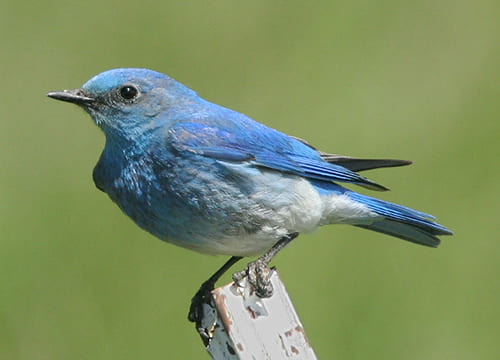Mountain Bluebirds (Sialia currucoides) are stunning cerulean-blue birds native to the mountainous regions of western North America.
You can see these beautiful birds hopping and hovering in search of food and hear them singing their sweet warbling songs atop treetops, posts, and powerlines.
On this page
Breeding Male
Male Mountain Bluebirds are painted in beautiful cerulean blue tones. Their uppersides are darker and their undersides lighter, fading to white at the rump. They have black eyes and a thin and short black bill.
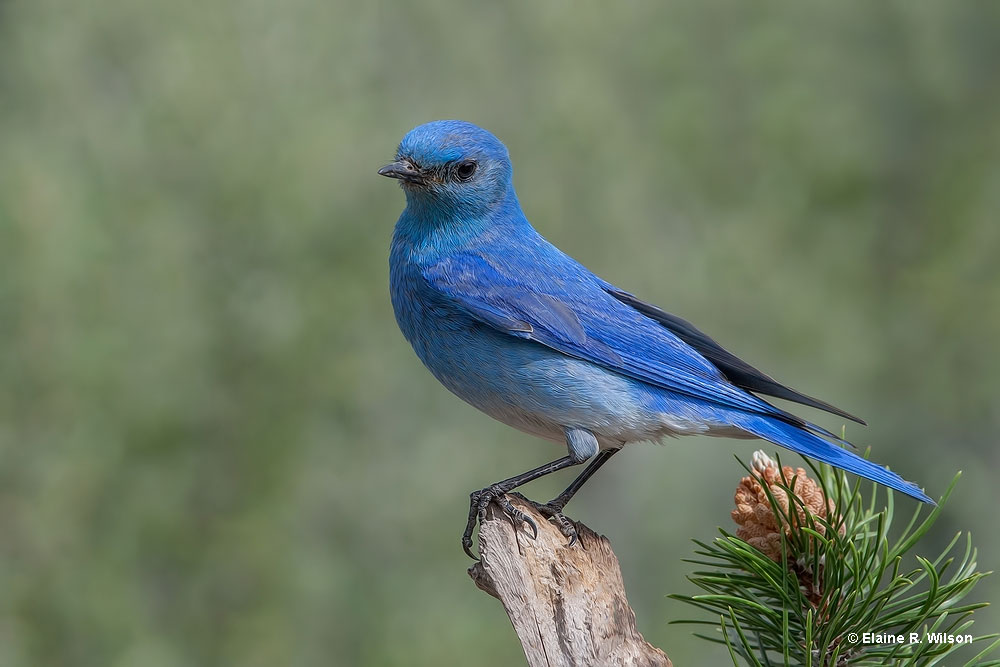
Female
Female Mountain Bluebirds are much more modest than their male counterparts. They have an overall brownish-gray plumage with blue tinges only in their wings and tail. Their upper chest, throat, and upper belly can vary from brownish-gray and ashy to faint rusty orange. Their eyes and bill are also black.
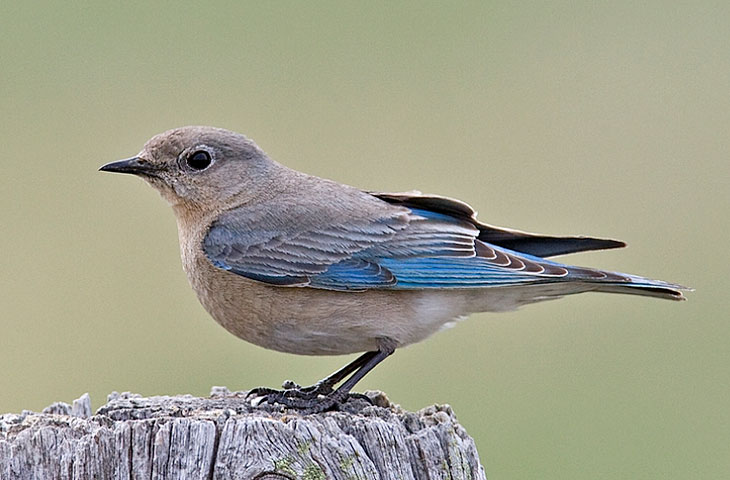
Photograph © Elaine Wilson
Juvenile
Mountain Bluebirds may have 2 broods in a year and lay 4-8, mostly 5-6 pale blue or occasionally white eggs in a clutch. The mother bird incubates them for about 13-21 days. Both parents take care of and feed the nestlings and the offspring leave the nest at about 17-23 days after hatching. They are still fed by their parents for another 3-4 weeks.
Juvenile Mountain Bluebirds look very similar to females, but they are duller and darker in color. Their upper flanks, breasts, and back are spotted with white. As they get older but haven’t still reached adulthood, the spotting in their plumage fades and they look identical to females.
These birds are fairly small, growing up to 8 inches long and weighing around 1.1 ounces.
Habitat
These birds breed in open woodlands or open areas that have bushes and a few trees, such as meadows and grasslands, and may winter in completely treeless terrain.
Mountain Bluebird habitats include prairies, sagebrush steppes, grasslands, alpine zones, and even farmlands, deserts, and plowed fields, but they avoid dense forests and very arid deserts.
They are most commonly found at middle and high elevations up to 13,000 feet.
They are cavity nesters and build them in natural hollows, such as holes in trees or crevices in cliffs, but will use birdhouses as well. The female gathers most of the materials and constructs the loose cup herself, making it just big enough to fit the eggs. It’s woven of different plant materials, such as small twigs, grass, stems, and needles, and lined with hair and feathers.
Diet
Mountain Bluebirds feed on both plant and animal matter. They prefer insects, small seeds, and fruits.
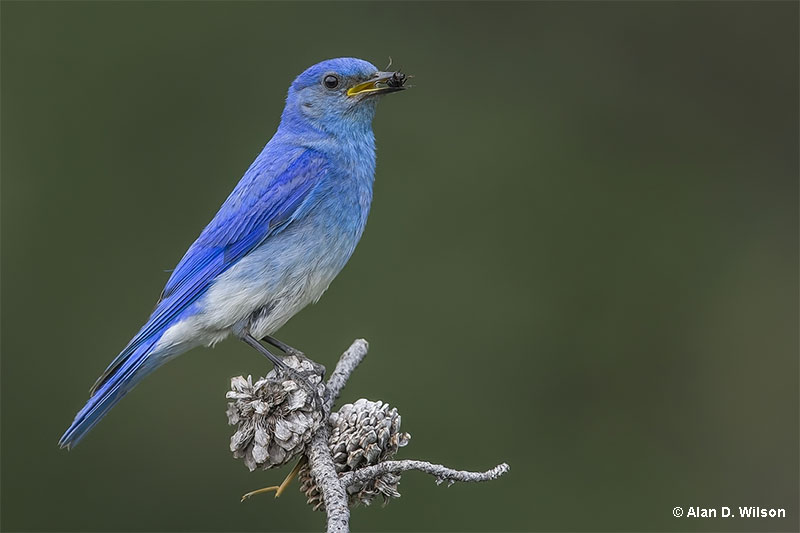
© Alan D. Wilson
The animal part of their diet consists of different insects, such as grasshoppers, cicadas, ants, bees, spiders, caterpillars, crickets, and beetles. The plant portion of their diet includes different seeds, berries, small fruit, and grains, including sumac, juniper, hackberry, mistletoe, grapes, elderberries, currants, and cedar berries.
During the summer, Mountain Bluebirds eat mainly insects. They have different methods of foraging. They may hover over an open area and drop down to catch the prey, catch insects mid-air, or perch on lower branches or rocks while scanning their surroundings. Berries and seeds become important during the winter. They may also visit birdfeeders for berries, peanuts, or mealworms.
Behavior
Mountain Bluebirds are not very social. During the breeding season, they’re highly territorial and fiercely defend their nesting and breeding territories.
Outside the breeding season, they form flocks of 30 or more birds, which may include birds from other species, such as Western Bluebirds.
Humans prize them for their beauty and usefulness. Since they’re insectivores, they keep the pest populations in check. Two states, Idaho and Nevada, have chosen this bird as their state bird.
Range (and seasonal changes)
Mountain Bluebirds range throughout western North America. Their range extends from northern Alaska to central Mexico.
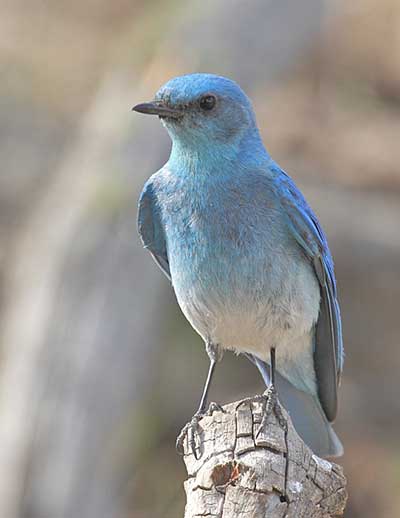
Mountain Bluebird
A big part of its population is migratory with its specific ranges varying from year to year depending on the availability of food. Its breeding range covers the northwestern United States, Canada, and Alaska. They fly to the southwestern United States and Central America for the winter. These birds inhabit Oregon, Nevada, Utah, New Mexico, Colorado, central California, and Arizona year-round.
Mountain Bluebird’s range and population are vast and, as such, the species is listed as of least concern on the IUCN Red List.
Wing shape
Mountain Bluebirds are small and stocky, although compared to other bluebirds they have a longer tail and appear lankier overall. Their wingspan is between 11 and 14 inches.
Mountain Bluebirds’ wings are on the shorter side and rounded, which allows them to take off quickly to evade predators and give them increased maneuverability.
Fun Facts
- Mountain Bluebirds are cavity nesters. Competition for nesting cavities is high and the females select their mate based on the suitability of the cavity the male offers.
- Mountain Bluebirds may interbreed with Eastern and Western Bluebirds. That occurs where their ranges overlap. Their hybrids appear blue overall but have rust-colored tips to their blue throat and breast feathers.
- They can fly up to 45 miles per hour and spot small insects in tall grass from up to 50 yards away.
- Mountain Bluebirds have been called “the bluest of the bluebirds” and are also known as the Arctic or ultramarine bluebird.
- Bluebirds symbolize all things good: joy, love, happiness, good luck, and hope.
Call
Mountain Bluebirds have two songs, both of which are low warbling whistles. At dawn, they sing a loud chirruping song, and during the day, you can hear them softly warble for many minutes. The phrases include feeer, perf, and chur chur.
Mountain Bluebird’s calls are short and modest. They may give a thin tew call or a high-pitched tink.
Similar Species
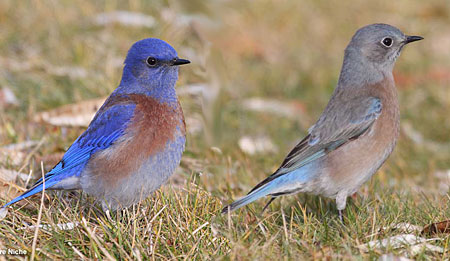
Western Bluebirds
Although Mountain Bluebirds and Western Bluebirds have some differences in their appearance, they share a similar range. Males look different from each other, but females look really similar.
Both bluebirds are similar in size.
Female Mountain Bluebirds have small white edges on their wings, Western Bluebirds lack these.
Frequently Asked Questions
How rare is the Mountain Bluebird?
Mountain Bluebirds are quite common in the open country of western North America. They have a large range and a big population of 6 million individuals.
What is the difference between a bluebird and a Mountain Bluebird?
Mountain Bluebirds have an overall sky-blue plumage, whereas the Eastern and Western Bluebirds have a rust-colored throat, chest, and lower abdomen.
Where do the Mountain Bluebirds live?
Mountain Bluebirds live in open habitats in western North America. Their range extends from Alaska to Central America.
What does it mean when you see a Mountain Bluebird?
Seeing a Mountain Bluebird, or any bluebird, is believed to bring good luck and happiness.

